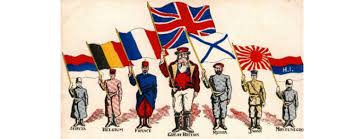“Nationalism” – Everything You Need to Know
Nationalism is one of the most influential—and sometimes controversial—ideologies shaping the modern world. It has inspired movements that led to the creation of nation-states, ignited passionate debates on identity and sovereignty, and, at times, fueled conflicts that reshaped international relations. In this comprehensive guide on Nationalism, we will delve into its definition, historical evolution, key attributes, and the multifaceted roles it plays in society today. Whether you’re a student of history, a political enthusiast, or simply curious about how the concept of nationalism continues to impact our global landscape, this article will provide you with a deep, nuanced understanding of the subject.
Introduction: The Power and Complexity of Nationalism
Imagine a world where millions rally under a single banner, united by shared history, language, and culture. What drives this unifying force? Did you know that modern nation-states—from the United States to India—are largely the products of nationalist movements? Nationalism has not only redefined borders and reshaped political institutions, but it has also had profound effects on social identity and cultural expression.
In this post on Nationalism, we will cover:
- A clear definition of nationalism and its essential characteristics.
- The historical background and key milestones that helped shape the evolution of nationalist thought.
- An in-depth exploration of various forms of nationalism, including political, cultural, and economic dimensions.
- Real-world examples and case studies that illustrate how nationalism has influenced historical events and modern politics.
- The significance of nationalism in everyday life and its applications across different domains.
- Common misconceptions and frequently asked questions, with clear answers.
- An examination of modern relevance, current trends, and debates surrounding nationalism.
Understanding Nationalism is vital for grasping how collective identity forms, how political borders are drawn, and why debates about sovereignty and self-determination remain so heated today. Let’s embark on this journey to uncover the layers behind one of the most potent forces in global politics.
What Is Nationalism?
A Straightforward Definition
Nationalism is an ideology and political movement that emphasizes the interests, culture, and values of a particular nation or group of people. It holds that individuals should be loyal to their nation-state and that a nation is best served when it governs itself independently. The essential characteristics of nationalism include:
Sense of Unity:
A belief in shared history, language, culture, or ethnicity that bonds individuals together into a collective identity.Sovereignty and Self-Determination:
The idea that nations should have the authority to govern themselves without external interference, often leading to demands for independence or autonomy.Pride and Patriotism:
A strong emotional attachment to one’s nation, often manifesting in patriotism and a commitment to national values.Political Mobilization:
The use of nationalist ideology to mobilize people for political action, whether to form a new state, resist foreign domination, or assert cultural identity.Cultural Preservation:
An emphasis on protecting and promoting the nation’s traditions, languages, and customs against perceived dilution or external influences.
By examining these core properties, we see that nationalism is more than just patriotism—it is a dynamic force that can shape political boundaries, social policies, and cultural identities.
Historical and Contextual Background
The Origins of Nationalism
The roots of nationalism can be traced back to the Enlightenment and the revolutionary movements of the late 18th century. Before nationalism became a dominant political force, the world was largely organized under monarchical and feudal systems, where loyalty was primarily to a ruler rather than to a nation. However, several key developments helped pave the way for modern nationalism:
The Enlightenment and Revolutionary Ideals
Intellectual Awakening:
Enlightenment thinkers such as John Locke, Montesquieu, and Rousseau introduced ideas about individual rights, the social contract, and popular sovereignty. Their writings questioned the divine right of kings and laid the groundwork for modern political thought.Revolutions as Catalysts:
The American Revolution (1775–1783) and the French Revolution (1789–1799) were watershed events that demonstrated the power of collective identity and the possibility of self-governance. These revolutions spread ideas of liberty, equality, and fraternity, setting the stage for nationalist movements.
Early Nationalist Movements
The Napoleonic Era:
Napoleon Bonaparte’s conquests inadvertently fueled nationalist sentiments across Europe. As people were subjugated by foreign armies, a sense of shared identity and resistance began to form.Cultural and Linguistic Nationalism:
During the 19th century, intellectuals and writers started to collect folk tales, songs, and traditions that highlighted the unique cultural identity of their peoples. This cultural nationalism played a crucial role in shaping political movements for self-determination.
Milestones in the Evolution of Nationalism
Unification Movements:
Perhaps the most significant examples of nationalism in action were the unification of Italy and Germany in the mid-19th century. In Italy, figures like Giuseppe Garibaldi and Count Camillo di Cavour harnessed nationalist sentiment to unite a fragmented peninsula into one nation. Similarly, Otto von Bismarck’s diplomatic and military maneuvers in Germany consolidated numerous independent states into a unified German Empire in 1871.Colonial Nationalism:
Nationalist ideas were not confined to Europe. In colonized regions, nationalist movements emerged as a response to imperial domination. Leaders in Latin America, Africa, and Asia drew on the language of nationalism to demand independence and self-governance.
Notable Anecdotes and Events
The American Revolution:
While often viewed through the lens of liberalism, the American Revolution also had strong nationalist elements. The rallying cry of “No taxation without representation” was as much about asserting a distinct American identity as it was about economic grievances.The Risorgimento in Italy:
The struggle for Italian unification, known as the Risorgimento, was marked by both military campaigns and cultural revival. Nationalist literature, art, and public celebrations played a key role in mobilizing support for unification.
In-Depth Exploration / Main Body
To fully appreciate Nationalism, it is essential to examine its various dimensions. We will explore its ideological roots, political expressions, social impacts, and cultural manifestations, using clear subheadings and real-world examples to illustrate its pervasive influence.
1. Ideological Foundations of Nationalism
a. The Concept of the Nation
Definition and Characteristics:
At its core, nationalism is about the idea of a nation—a group of people united by shared characteristics such as language, culture, history, or ethnicity. Unlike earlier forms of loyalty based on feudal or dynastic ties, nationalism places the nation at the center of political identity.Emotional and Psychological Dimensions:
Nationalism often evokes strong emotional responses, including pride, solidarity, and sometimes, xenophobia. These sentiments can inspire collective action but can also lead to exclusionary practices.Philosophical Underpinnings:
Influential thinkers like Johann Gottfried Herder argued that language and culture are the soul of a nation. His ideas helped to shift the focus from loyalty to a ruler toward loyalty to a shared cultural identity.
b. Competing Ideologies: Liberalism, Socialism, and Conservatism
Nationalism and Liberalism:
Liberal nationalism emphasizes individual freedoms and democratic governance while advocating for national self-determination. It was a driving force behind many independence movements.Nationalism and Socialism:
In some contexts, nationalism merged with socialist ideals to form a unique ideology that aimed to address both national self-determination and economic justice. This blend was particularly influential in post-colonial contexts.Nationalism and Conservatism:
Conservative nationalism tends to emphasize tradition, cultural continuity, and social stability. It often arises as a reaction against rapid social change and the perceived threats to established social orders.
2. Political Expressions of Nationalism
a. Nationalist Movements and State Formation
Unification and Independence:
The creation of new nation-states is one of the most visible outcomes of nationalist movements. The unification of Germany and Italy are prime examples where nationalist sentiment led to the consolidation of multiple states into a single political entity.Case Study – German Unification:
Otto von Bismarck’s Realpolitik and strategic wars against Denmark, Austria, and France were instrumental in uniting the German states. Nationalism provided the ideological glue that transformed a collection of principalities into a modern nation-state.Colonial Liberation:
In the 20th century, nationalist movements played a key role in decolonization. Leaders like Mahatma Gandhi in India used nationalist rhetoric to mobilize the masses and achieve independence from British rule.
b. Nationalism in Political Institutions
Electoral Politics and Party Systems:
Nationalist ideas have often been at the heart of political parties. In Europe, parties with nationalist platforms have shaped electoral politics, influencing policy on immigration, cultural identity, and foreign affairs.Public Policy and National Identity:
Governments frequently use nationalist rhetoric to legitimize policies. For example, debates over citizenship, language laws, and national symbols are all infused with nationalist sentiment.Modern Examples:
Today, nationalist parties and movements are prominent in many countries, from the right-wing populism in Europe to movements in Asia and Latin America that emphasize national sovereignty and cultural preservation.
3. Social Impacts of Nationalism
a. Shaping Social Identity
Formation of Collective Identity:
Nationalism plays a crucial role in shaping how people see themselves as part of a larger community. It creates a sense of belonging and shared destiny, which can be empowering but also exclusionary.Cultural Revival:
Nationalist movements often spur a renaissance in arts, literature, and folklore as a way to rediscover and celebrate a nation’s heritage. This cultural revival reinforces national identity and pride.Case Study – The Irish Revival:
The late 19th and early 20th centuries saw a resurgence of Irish cultural nationalism, with efforts to revive the Irish language, traditional music, and folklore as expressions of national identity in the face of British domination.
b. Social Cohesion and Conflict
Uniting or Dividing Societies:
Nationalism can serve as a powerful force for unification, but it can also lead to social fragmentation. While it may strengthen bonds within a group, it can simultaneously foster hostility toward those perceived as outsiders.Ethnic and Regional Tensions:
In multi-ethnic states, nationalist sentiments can lead to demands for autonomy or even secession. The breakup of empires in the 20th century, such as the Austro-Hungarian and Ottoman Empires, provides stark examples of how nationalism can both unite and divide.Modern Implications:
Today, debates over immigration, minority rights, and regional autonomy often center on nationalist ideas, highlighting the continuing relevance—and potential risks—of this ideology.
4. Economic Dimensions of Nationalism
a. Economic Nationalism and Protectionism
Defining Economic Nationalism:
Economic nationalism involves policies that prioritize the interests of a nation’s economy, often through protectionist measures like tariffs and trade barriers. It is driven by the desire to safeguard domestic industries and promote national self-sufficiency.Historical Context:
In the 19th century, economic nationalism was often intertwined with the broader nationalist movement. Countries sought to reduce dependence on foreign powers and build robust domestic industries.Modern Trends:
In recent years, economic nationalism has reemerged in various forms, as seen in debates over free trade, globalization, and domestic job protection. Policies that favor local production and reduce reliance on international supply chains echo the nationalist impulses of the past.
b. Resource Control and Economic Independence
Nationalization of Industries:
In some instances, nationalist governments have sought to assert control over key industries—such as oil, mining, and utilities—to ensure that natural resources benefit the nation as a whole.Case Study – Latin America:
Throughout the 20th century, many Latin American countries nationalized their natural resources as part of broader nationalist policies aimed at redistributing wealth and reducing foreign influence.Economic Sovereignty:
Economic policies rooted in nationalism often stress the importance of sovereignty and self-reliance, advocating for strategic control over a nation’s economic destiny.
5. Nationalism in the Cultural Sphere
a. Cultural Nationalism and Identity
Reviving Heritage:
Cultural nationalism emphasizes the importance of preserving and promoting a nation’s cultural heritage. This can include language, traditions, folklore, and historical narratives that define a group’s identity.Role of Arts and Literature:
Nationalist movements have long used literature, music, and art to articulate and disseminate their vision. For instance, the Romantic movement in Europe celebrated the unique character of different nations through poetry, painting, and music.Modern Cultural Nationalism:
Today, debates over cultural nationalism continue in areas such as language policies, education curricula, and media representation. These discussions highlight the ongoing importance of cultural identity in a globalized world.
b. National Symbols and Public Memory
Symbols of Nationhood:
Flags, anthems, and national monuments serve as powerful symbols of national identity. They encapsulate a nation’s history, struggles, and aspirations.Public Ceremonies and Rituals:
National holidays, commemorative events, and public ceremonies reinforce collective memory and foster a sense of belonging. These rituals are integral to the maintenance of a national identity.Case Study – Memorials and Monuments:
The construction of monuments such as the Arc de Triomphe in France or the Statue of Liberty in the United States reflects the importance of national symbols in shaping public identity and political narratives.
Importance, Applications, and Benefits
Understanding Nationalism is essential for grasping the forces that shape political boundaries, social identities, and cultural expressions. Here are some key benefits and applications of studying nationalism:
a. Informing Policy and Governance
- Designing Inclusive Policies:
Insights into nationalist dynamics can help policymakers craft policies that balance national pride with inclusivity, reducing the risk of exclusionary practices. - Conflict Resolution:
Understanding the roots of nationalist sentiment is critical for resolving ethnic and regional conflicts, both domestically and internationally. - Global Diplomacy:
Nationalism plays a significant role in international relations. Knowledge of nationalist trends helps diplomats navigate negotiations and build cooperative frameworks.
b. Enhancing Civic Engagement
- Political Literacy:
A well-informed citizenry that understands the historical and ideological dimensions of nationalism is better equipped to participate in democratic processes. - Community Building:
Nationalist narratives can both unite and divide. By critically examining these narratives, communities can foster a more inclusive and constructive sense of identity. - Empowering Minorities:
Awareness of the dynamics of nationalism can help marginalized groups advocate for their rights and preserve their cultural heritage within a broader national framework.
c. Economic and Cultural Development
- Promoting Sustainable Growth:
Economic nationalism, when balanced with global cooperation, can foster domestic industries and promote sustainable development. - Cultural Preservation:
Cultural nationalism encourages the preservation of heritage and traditions, enriching the diversity of global culture. - Innovation and Identity:
National identity can be a source of inspiration and innovation, driving creative expression and technological advancement.
d. Academic and Intellectual Enrichment
- Interdisciplinary Insights:
The study of nationalism bridges history, political science, sociology, and cultural studies, offering a comprehensive understanding of how societies evolve. - Critical Analysis:
Analyzing nationalism sharpens critical thinking skills, enabling individuals to assess the impact of ideology on politics and society. - Future Forecasting:
By understanding historical nationalist movements, scholars and policymakers can better predict and respond to contemporary trends.
Addressing Common Misconceptions and FAQs
Despite its prominence, nationalism is often misunderstood. Below are some frequently asked questions and clarifications:
FAQ 1: Is nationalism inherently xenophobic or exclusionary?
- Misconception:
Many people assume that nationalism always leads to intolerance or aggression toward outsiders. - Reality:
While some forms of nationalism have been exclusionary, there are also civic or inclusive forms of nationalism that emphasize unity, shared values, and the protection of diverse cultural identities.
FAQ 2: Does nationalism only refer to the political independence of a nation?
- Misconception:
Nationalism is sometimes narrowly defined as the struggle for independence or the formation of a nation-state. - Reality:
Nationalism encompasses a broad range of ideas, including cultural preservation, economic self-determination, and the creation of a collective identity. Its applications go far beyond political independence.
FAQ 3: Are nationalist movements a thing of the past?
- Misconception:
Some argue that nationalism is an outdated ideology, irrelevant in the modern, globalized world. - Reality:
Nationalism remains a potent force today, influencing debates on immigration, cultural identity, and global governance. Its manifestations may have evolved, but its core principles continue to shape public discourse.
FAQ 4: Is nationalism solely a Western phenomenon?
- Misconception:
It is often believed that nationalism only emerged in Europe and North America. - Reality:
Nationalist movements have occurred worldwide. In Asia, Africa, and Latin America, nationalism has been a critical tool in anti-colonial struggles and the formation of modern nation-states.
Modern Relevance and Current Trends
a. Nationalism in the 21st Century
Digital Nationalism:
Social media and the internet have transformed how nationalist ideas are communicated and mobilized. Online platforms enable the rapid spread of nationalist sentiment, both inclusive and exclusionary, across borders.Populist Movements:
In many countries, populist political movements draw on nationalist rhetoric to address grievances related to globalization, immigration, and economic inequality. These movements continue to reshape political landscapes.Globalization vs. National Sovereignty:
The tension between global integration and national autonomy remains a central debate. Countries grapple with maintaining sovereignty while participating in an interconnected global economy.
b. National Identity and Cultural Revival
Revival of Traditional Culture:
In response to globalization, many nations are actively promoting their cultural heritage as a source of national pride. This cultural revival is often intertwined with nationalist rhetoric.Education and National Narratives:
Governments and educational institutions are reexamining how national history is taught, sometimes emphasizing narratives that promote unity and pride, while at other times reassessing past injustices.Art and Media:
Contemporary artists, filmmakers, and writers frequently explore themes of nationalism, reflecting on its impact on identity and community in a modern context.
c. Debates on Immigration and Multiculturalism
Policy Challenges:
Nationalist sentiments often come to the fore in debates about immigration, integration, and multiculturalism. While some advocate for strict border controls and cultural preservation, others push for inclusive policies that embrace diversity.Economic Implications:
The economic impacts of immigration—such as labor market dynamics and social services—are frequently discussed in nationalist contexts, influencing public policy and political debates.Social Cohesion:
Striking the right balance between preserving national identity and fostering an inclusive society remains one of the most significant challenges facing modern nations.
d. Future Directions in Nationalist Thought
Evolution of Ideologies:
As global challenges evolve, nationalist ideologies are also transforming. There is a growing conversation about “civic nationalism” versus “ethnic nationalism” and how these models can coexist in increasingly diverse societies.Sustainability and National Development:
Some contemporary nationalist movements are incorporating sustainability into their agendas, promoting economic policies that balance national interests with environmental stewardship.Transnational Nationalism:
In a globalized world, the concept of nationalism is also being redefined through transnational movements that seek to address global issues while maintaining local identities.
Conclusion: The Enduring Power of Nationalism
Summarizing the Key Points
Nationalism is a multifaceted ideology that has played a crucial role in shaping the modern world. Key insights from our exploration include:
Core Characteristics:
Nationalism is defined by a shared sense of identity, a desire for self-determination, and the mobilization of collective sentiment. It encompasses cultural, political, and economic dimensions.Historical Evolution:
The emergence of nationalism can be traced to the Enlightenment, the revolutionary movements of the 18th century, and the dynamic changes of the 19th century. Key events like the unification of Italy and Germany and the struggles for independence in colonized regions illustrate its transformative power.Political and Social Impact:
Nationalism has influenced the creation of modern nation-states, the expansion of democratic rights, and ongoing debates about identity, sovereignty, and cultural preservation.Modern Relevance:
Despite evolving in form, nationalism remains a potent force in today’s political discourse, affecting issues from immigration and globalization to economic policy and cultural revival.Empowerment Through Understanding:
By studying nationalism, we gain insights that empower us to engage in informed debates, shape public policy, and build inclusive societies.
Reinforcing the Importance of Nationalism
Understanding Nationalism is essential for anyone seeking to comprehend the dynamics of modern politics and society. Its historical roots and ongoing evolution offer critical lessons about the formation of collective identity, the power of political mobilization, and the challenges of balancing unity with diversity.
A Call-to-Action
We invite you to:
- Explore Further:
Delve into books, documentaries, and academic research on nationalism to expand your knowledge of its history and contemporary relevance. - Engage in Discussion:
Share your thoughts, questions, and experiences in the comments below or on our social media platforms. How do you see nationalism influencing your community or country today? - Stay Informed:
Subscribe to our newsletter for more in-depth articles on historical transformations, political ideologies, and social change. Your engagement is vital in building a well-informed community that can navigate the complexities of modern identity and governance.
Additional Resources and Further Reading
For those interested in exploring Nationalism further, consider these reputable sources:
Books and Academic Journals:
- Imagined Communities: Reflections on the Origin and Spread of Nationalism by Benedict Anderson
- Nationalism by Eric Hobsbawm
- The Invention of Tradition edited by Eric Hobsbawm and Terence Ranger
- Articles in journals such as Nations and Nationalism and The Journal of Modern History.
Digital Archives and Museums:
- The Digital Public Library of America (DPLA) for historical documents related to nationalist movements.
- Europeana Collections, featuring digitized artifacts and records from 19th-century nationalist movements.
Government and Educational Websites:
- Resources from the U.S. Library of Congress and the British Library.
- Online courses on platforms like Coursera, edX, and Khan Academy covering nationalism and modern history.
Interactive Timelines and Documentaries:
- Multimedia timelines on History.com that illustrate the development of nationalist movements.
- Documentaries available on PBS, Netflix, or YouTube that explore the rise and impact of nationalism worldwide.
Final Thoughts
The concept of Nationalism remains one of the most powerful and complex forces shaping our modern world. By examining its historical evolution—from the Enlightenment to the revolutions and state formations of the 19th century—we gain a deeper understanding of how nations are built and how identity and sovereignty are constructed. The lessons of nationalism offer invaluable insights into the balance between unity and diversity, the challenges of globalization, and the ongoing debates about the role of the state in modern society.
Thank you for joining us on this comprehensive exploration of Nationalism. If you found this post insightful, please share it with friends, colleagues, and anyone interested in understanding the enduring impact of nationalist thought on global politics and society. Let’s continue the conversation and work together to build a more informed, inclusive, and dynamic future.







